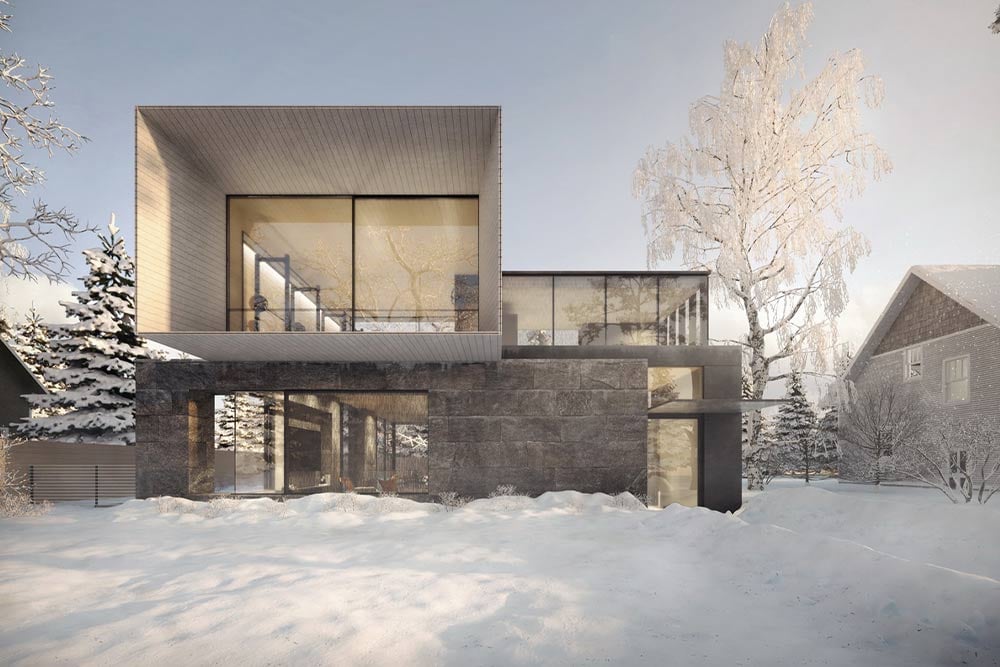
Many people would like to build a modern home in a mountain landscape, such as Aspen or Lake Tahoe. For some, the desire to build in the mountains is connected to a particular landscape or view. For others, it’s a desire to escape the hustle and bustle of city life. And for others still, it’s the proximity to recreational activities such as favorite skiing, snowshoeing, or hiking trails.
While the reasons vary, one thing that remains true is that modern mountain architecture shares certain characteristics and challenges. Below, we explore the unique challenges of building a home in the mountains and discuss what we consider to be the main defining characteristics of modern mountain architecture.
Challenges of Building in the Mountains
When you decide to build a home in a mountain landscape, it’s important to recognize that your project will face unique challenges due to the location and climate, especially compared to building on the coast or in an urban environment.
These challenges can include:
- Greater volumes of snowfall, which can lead to logistical challenges as well as material degradation.
- Greater temperature fluctuations between day and night, especially in the winter months, which leads to the expansion and contraction of materials. Over time, this can cause degradation and structural issues.
- Greater UV exposure due to higher elevations, which can lead to color fading.
- Design and height restrictions imposed by an HOA or “view committees” which are often tasked with ensuring that the mountain landscape be preserved. These limitations may require you to get creative in your home’s layout and program.
And of course there is the fact that building in the mountains, by its very nature, increases the likelihood that you will be building in a remote location which may or may not have access to utilities hookups such as electricity, water, sewer, etc. If the location does not have access to these hookups, putting alternatives in place may be required. For example, you might leverage a septic tank in place of a sewer line or self-contained energy options (propane, solar, geothermal) in place of electricity and natural gas. Each of these options can add to the final complexity and cost of your project, and must be factored into the plan.
What is mountain modern architecture?
Mountain modern is a term used to describe modern architecture as it is applied in mountain locations. This can include both residential architecture, as in a home, as well as resort architecture or, in some cases, commercial architecture.
Mountain modern follows many of the same tenets of what we call classical California modernism. The key difference is that these tenets are approached through the lens of mountain living.
Mountain modern, as a school of design, seeks to address the challenges discussed above while still building a home that aligns with the overall tenets of modern architecture. Below is a look at the defining characteristics of mountain modern homes.
Characteristics of Mountain Modern Architecture
1. Connection to Site
Connection to site is an important characteristic of all modern architecture, regardless of setting, whether it is located along the coast or the mountains.

What this means is that the home should feel congruent with its setting. Material palette, color choice, and form should all work together with the site to give the impression that the home you build was meant to be built there. Instead of overpowering the setting, the home should coexist harmoniously with it.
It also means that when the individual is standing inside the home, they feel connected to the outdoor spaces in some way. This can be achieved in a number of ways—for example, by leveraging glass throughout the home in order to bring the outdoors in, or by extending the exterior material palette into the interior of the home.
2. The Home’s Program
Many people who make the decision to build a home on a mountain do so in part for the stunning views that such a location offers. In order to maximize the enjoyment of these views, it will be necessary to think creatively about the home’s program and how the spaces are laid out. The simple act of rotating the program of the home, for example, can make all the difference in creating a stunning view up or down the mountain from a primary living space.

Of course, the mountain setting will also require certain logistical details as well which can be easy to overlook but which are critical to designing a well-functioning home. Just a few possible examples might include:
- A covered entry to prevent snowfall from blocking access to the home
- Deep overhangs around windows and other access points, for the same reason
- A vestibule or mudroom where the inhabitants can remove muddy boots and snow-covered jackets or gear
- A secondary entry sequence for when inhabitants enter through the garage, which is increasingly likely in periods of inclement weather
Likewise, you’ll need to consider the home’s elevation. If you will be leveraging floor-to-ceiling glass windows throughout the home in order to create views, it’s important to consider that deep snow is likely to accumulate in the winter months. This snow, when pressed against glass, will not only diminish any view that you create, but can also lead to structural damage over time. By elevating the foundation of the home even just a few feet, you can greatly reduce this risk.
3. Sloped Roofs
Flat roofs are very common in modern architecture. This is partly due to the fact that modern architecture originated in warmer environments where snowfall wasn’t a concern. This allowed those trailblazing architects to toss aside the sloped roofs required elsewhere in order to create a truly modern look.

In a mountain environment, snow accumulation is of course a risk, and something which must be accounted for. Sloped roofs combat the risk of structural collapse by shunting the snow off of the home and, ideally, away from entryways and primary paths. Simply put, even though sloped roofs may not be the first image that jumps to mind when you think of modern homes, they are often a requirement in mountain locales.
4. Material Palette
Due to the increased stresses that your home will receive in a mountain landscape, material selection will play an essential role in the design process as well. Some materials will be better suited to a mountain environment, while others will not be.

Especially in the winter months, your home will undergo significant temperature swings over the course of a single 24-hour period: Freezing temperatures at night, and then periods of relative warmth in the light of day. These rapid changes in temperature can cause certain materials, such as plaster and certain metals, to expand and contract. This in turn leads to structural damage over time. Concrete, masonry, and certain types of wood, by comparison, handle these changes in temperature and harsh weather conditions more effectively.
5. Color Palette
On the coast, you tend to see homes built with lighter color palettes in mind: White, blue, beige, etc. In the mountains, by comparison, you are more likely to see darker, earthier tones. While material selection plays at least some role in determining this color scheme, there are other factors to consider as well.

Aside from aesthetic reasons, darker colors tend to be leveraged in mountain settings for a number of logical reasons. First, darker colors will allow your home to absorb more of the sun’s heat during the day. This solar heat gain will then be retained, and can lower how much energy you must consume to keep your home comfortable at night.
Second, darker colors are less likely to create glare. At higher elevations, the sun is much stronger than at lower elevations. This can cause issues not only for people viewing the home from the outside, but also for those looking out of the home. Darker colors and non-reflective coatings, paired with glare-resistant glass, reduces this risk.
Designing a Mountain Modern Home
If you are interested in designing and building a mountain modern home, it’s important to bear in mind the factors discussed above. It’s also critical that you work with an architect who is experienced in handling the unique challenges presented by building in a mountain landscape. The right architect will be able to abate these challenges while guiding you to the home of your dreams.

Written by Bryn Garrett
Since joining Ehrlich Yanai Rhee Chaney Architects in 2012, Bryn Garrett has been involved with a broad range of the firm’s portfolio, from custom residential and hospitality, to commercial, institutional and creative office. Having equal experience in many aspects of the practice gives him a unique perspective on a project’s context, materiality and environmental impact. Bryn is heading EYRC’s San Francisco studio, which opened in 2017.
